A survey of the music books published in the last 10 years reveals the breadth and depth of the music community in New Zealand, with memoirs from original punks and indie icons, musical outliers, indie label bosses, mainstream outlaws, and lesser-known 1960s icons. Histories of trans-Tasman musicians, a near-contemporary urban Pasifika and Māori scene and label, and collections of images from on-the-scene photographers broaden the picture. It’s an exciting time to be a contemporary music historian in New Zealand.
Jazz, folk, classical music and culture have always had an evaluative advantage over popular music, having long been embedded in institutions of higher learning with the resulting consistent funding and endowments that support writers and allow deeper investigation. Which is why the publications produced by that milieu have tended to the overly academic and elite.
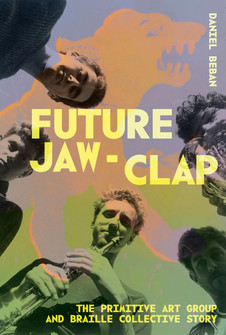
Daniel Behan, Future Jaw-Clap: The Primitive Art Group and Braille Collective Story (Te Herenga Waka University Press, 2024)
Not so Daniel Beban’s ground-breaking history of Wellington’s The Primitive Art Group and the associated Braille Collective. There’s a lot of the freeness and challenge of that distinctive community’s sounds in the author’s work as he gathers the key movers at this fascinating collective’s core and those they attracted and motivated in their determined free-jazz-punk journey. As he does, Wellington gets a vigorous and more convincing revisit as its 1980s and 1990s streets and buildings and new cultural infrastructure come alive again in Beban’s Future Jaw-Clap: The Primitive Art Group and Braille Collective Story (Te Herenga Waka University Press, 2024).
Fellow Wellingtonian Nick Bollinger adds another earlier angle on the capital’s counter-cultural project with his insightful and highly readable Goneville: A Memoir (Awa Press, 2016), which tracks the young musician and son of the city’s emerging cultural elite, through the eye-opening late 1960s into the even weirder 1970s.
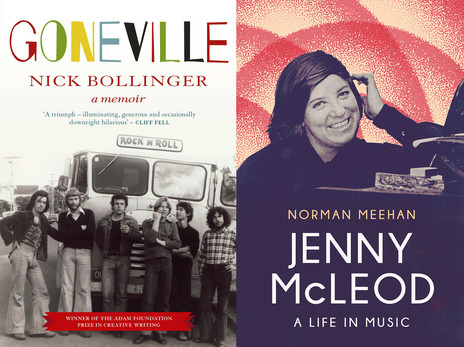
Nick Bollinger, Goneville: A Memoir (Awa Press, 2016); Norman Meehan, Jenny McLeod: A Life In Music (Te Herenga Waka University Press, 2023)
Having already done justice to New Zealand’s international jazz great in Serious Fun: The Music and Life of Mike Nock (VUP, 2010), Norman Meehan turns to one of New Zealand’s most prolific – and heard – contemporary classical musicians and composers in Jenny McLeod: A Life In Music (Te Herenga Waka University Press, 2023). There’s a warmth there and clear affection for his subject, buoyed by McLeod’s personality and undeniable joy and resolve in pursuing her musical gift and the broader counter-cultural and social contexts she embraced that makes for a quietly compulsive read.
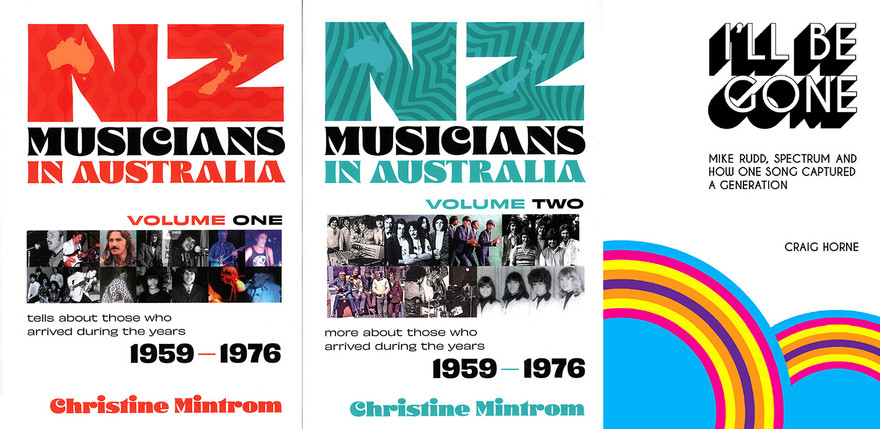
Christine Mintrom, NZ Musicians in Australia 1959-1976 (2024); Craig Horne, I’ll Be Gone: Mike Rudd, Spectrum and How One Song Captured a Generation (Melbourne Books, 2020)
The 1960s generation’s pop and rock division, trans-Tasman branch, is ably mustered by Christine Mintrom in her historically and factually sound, self-funded and published two-volume, NZ Musicians in Australia 1959-1976 (2024). More a thorough and wide-ranging segmented survey than a cohesive book, Mintrom comes at her subject from every possible angle, locating many participants who have never spoken before (in this context). There are detailed memories from producer Howard Gable, Larry’s Rebels’ John Williams, The Librettos’ Brian Peacock and Simple Image’s Barry Leef, amongst many others. Mintrom also accesses the available archival sources well, providing plenty of starting points and sparks for the work that still needs to be done on this important time. (An excerpt from volume two, “New Zealand Musicians in Sydney”, has been published on AudioCulture.)
You’ll find plenty about Christchurch’s Mike Rudd in Mintrom’s books. Rudd’s an important figure, not just for his time in Garden City’s R&B wild men Chants R&B, but also the much longer and more productive creative life he had as an underground musician and composer and Australian music chart topper in Spectrum, Ariel and Mike Rudd and The Heaters in Melbourne. Like The La De Da’s, there seem to be two completely different entities there – one New Zealand and one Australian – when in reality it’s a progression that Melbourne music historian, Craig Horne, captures and tells well in his trans-Tasman biography, I’ll Be Gone: Mike Rudd, Spectrum and How One Song Captured a Generation (Melbourne Books, 2020).
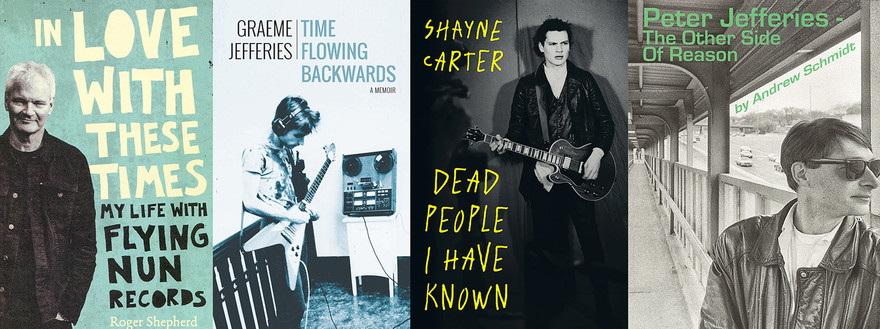
Left to right: Roger Shepherd, In Love With These Times (Harper Collins, 2016); Graeme Jefferies, Time Flowing Backwards (2018); Shayne Carter, Dead People I Have Known (Victoria University Press, 2019); Andrew Schmidt, Peter Jefferies - The Other Side of Reason (2024)
The 1980s were one of the country’s most musically productive decades and a time when the rock and pop music community and industry became a permanent and accepted part of our culture. There’d be no more talk of popular culture being a fad or series of fads of little intellectual value or societal resonance. Whole lives would live in its sway to a soundtrack indigenous to these shores. Just ask Roger Shepherd, the founder of the Flying Nun Records label (In Love With These Times, 2016) or punk and post-punk musicians’ Graeme Jefferies (Time Flowing Backwards, 2018), Shayne Carter (Dead Famous People, 2019), and Peter Jefferies (The Other Side of Reason, 2024; full disclosure, I wrote it), who have told or had their stories told well in recent times. (An excerpt from The Other Side of Reason is on AudioCulture.)
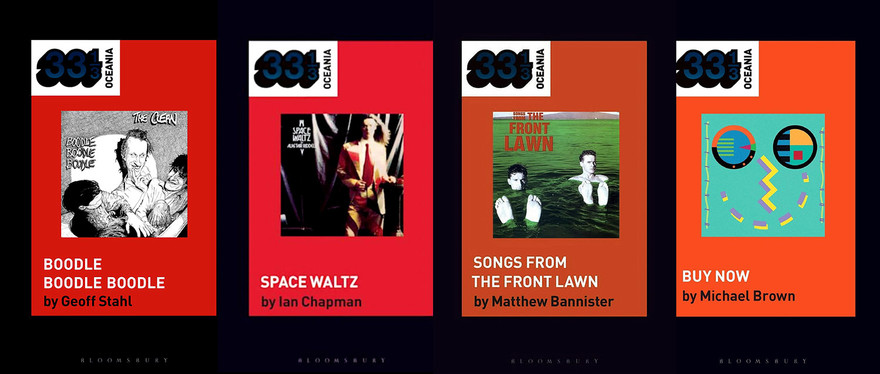
Geoff Stahl, Boodle Boodle Boodle (2025); Ian Chapman, Space Waltz; Matthew Bannister, Songs From the Front Lawn; Michael Brown, Buy Now (2025). All from the Bloomsbury Academic's 33 1/3 Oceania series
Local academics who are also musicians, Ian Chapman and Matthew Bannister, Victoria University sociologist Geoff Stahl, and Michael Brown put their hand up with four booklets for Bloomsbury Academic’s 33 1/3 Oceania series, spotlighting Space Waltz’s self-titled 1975 LP, The Front Lawn’s Songs From The Front Lawn (2023), and The Clean’s Boodle Boodle Boodle EP. All are good reading in their own way with Stahl’s being the pick thus far. He has a real feel for the music and the environment in which it was created and, in turn, created, and displays a good awareness of the contemporary arguments and thoughts around the time and music. Michael Brown’s Buy Now, about Eyeliner’s 2015 album, was published just after this survey was written, as was Australian author Barnaby Smith’s 33 1/3 book on the Crowded House album Together Alone.
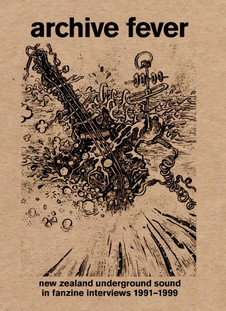
Noel Meek ed., Archive Fever: New Zealand Underground Sound in Fanzine Interviews, 1991-1999 (Oslo: Marhaug Forlag, 2023). - Cover illustration by Stefan Neville (Pumice)
There’s always more to the story than just the actual music; of course. There are the media in which it is articulated, evaluated, and publicised. Music fanzines have a long and broad history here, as Bryce Galloway’s upcoming oral history will soon reveal. These small-run publications can often be willfully partisan as Noel Meek’s Archive Fever: New Zealand Underground Sound in Fanzine Interviews, 1991-1999 (2023), a fascinating gathering of exactly reproduced interviews from era fanzines Spec, Bananafish, In-Sample, Astronauts, Valve, De-create, and Opprobrium shows. Therein a select group of the more left-field artists associated with the indie and experimental music scenes in New Zealand reveal themselves.
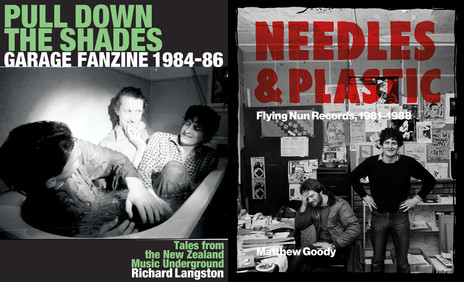
Richard Langston, Pull Down The Shades: Garage Fanzine 1984-86: Tales from the New Zealand Music Underground, Second edition (Chicago: HoZac Books, 2023); Matthew Goody, Needles and Plastic: Flying Nun Records, 1981-1988 (Auckland University Press, 2022)
You’ll find plenty about Richard Langston’s ground-breaking mid-1980s Dunedin fanzine Garage elsewhere on AudioCulture, but there’s nothing like having the original work reproduced exactly and supplemented by new music interviews that extend the picture as Richard has done under Todd Novac’s able editorship at Chicago’s Hozac Books in Pull Down The Shades: Garage Fanzine 1984-86: Tales from the New Zealand Music Underground (2023). If you have any interest in New Zealand’s punk, post-punk, and indie music of the 1980s and beyond, this is a good place to start.
Matthew Goody takes a more record-centric approach in Needles and Plastic: Flying Nun Records, 1981-1988 (Auckland University Press, 2022), his thorough investigation and spirited evaluation of the music from the indie label’s most important era. While there’s plenty here to satisfy those new to the subject and old hands alike, a more expansive historical telling taking in the primary spaces of encounter, such as live shows, television, student radio, and print, is still needed. Another great place to begin, though. (Read an excerpt from Needles and Plastic on Look Blue Go Purple's Bewitched EP here.)
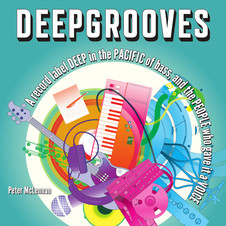
Deepgrooves: A record label deep in the Pacific of bass, and the people who gave it a voice by Peter McLennan (Auckland: Dunbar Noon, 2024)
Histories of music labels are at their best stories of communities, their origins, events and achievements, and the participants humanity, good, bad, and indifferent. They are tales deeply rooted in their time and place. Peter McLennan’s Deepgrooves: A Record Label Deep in the Pacific of Bass, and the People Who Gave It A Voice (Dunbar Noon, 2024) is such a work. A no-ifs, no-buts, no apologies telling of a historically concise and culturally important time in New Zealand’s most internationally open and ethnically diverse city, where marginalised Māori and Pasifika youth and inner-city hipsters came together.
McLennan draws well on written, aural and visual sources, building the story further with recent interviews. However there is no author interview with Kane Massey, the personality at the centre of the label. Massey ducks and dives through the text as he does in life. Photographs and posters from the label’s deep catalogue are also largely missing.
If this were a work solely about Massey, that would be a problem, but it’s not; it’s a community history, where the true nature of music scenes – people coming into the inner city from the suburbs and other towns and centres galvanised by new sounds, technology and possibilities – comes alive on the page. There are so many characters involved, it’s hard to pick highlights here; they all have a compelling story behind them. Coupled with vibrant reflections of shows and events such as the Proud national tour and wonderful glimpses of suburban Auckland like the Gemini Record store in Ōtāhuhu, which challenges the external view of Auckland as a monolithic entity, as opposed to the wide and diverse collection of urban communities it is.
Dare I say it, given Massey’s professed interest in film, that this would make for a brilliant movie.

Alexander Hallag, Shhh ... the music is talking (AH23 Publications, 2015); Stephen Penny, Punk shots, Auckland, 1978/80 (self-published, 2020), Anthony Phelps, From AK79 to the class of 81: photos from 1978 to 1982 (and a few more) (Blenheim: Anthony Phelps, 2021); Jonathan Ganley, Crush: Photos From Post-Punk Auckland (self-published, 2023)
Wherever a music scene existed, a photographer was usually close by capturing it as a recent clutch of eye-catching photo books shows. Alexander Hallag’s vibrantly shot Shhh … The Music is Talking (AH23 Publications, 2015) takes a recent view of our performers while Anthony Phelps’ From AK79 To The Class of 81 (self-published, 2021) points a lens at another particularly vibrant time in the Queen City’s music life, as the city moved through its initial punk phase into its vital post-punk and indie era. Stephen Penny’s Punk Shots, Auckland, 1978/80 (self-published, 2020) is almost a prequel gathering of the groups and personalities up from the beginnings of punk in the city. I like the way Jonathan Ganley has annotated his images in Crush: Photos From Post-Punk Auckland (self-published, 2023). It adds a personal touch to yet another compelling collection of photographs. As a historian covering these eras, I was already familiar with work from all three men, but the images I’d received from band members rarely came with a photo credit so it’s nice to see their work properly attributed.
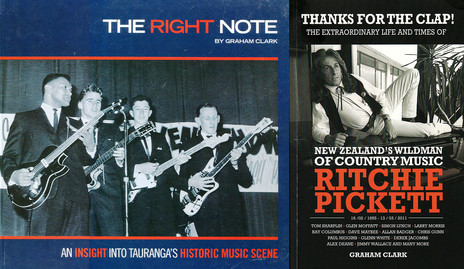
Graham Clark, The Right Note: An Insight into Tauranga's Historic Music Scene (Clark Design, 2015); and Thanks For The Clap! The Extraordinary Life and Times of New Zealand’s Wildman of Country Music Ritchie Pickett (Clark Design, 2017)
There’s a very real lack of regionally centred local music histories which makes Graham Clark’s sprawling The Right Note: An Insight into Tauranga’s Historic Music Scene (Clark Design, 2015) particularly welcome. Graphically strong, well laid out and printed with an impressive historical spread of the city’s groups and performers, venues and associated characters, there’s clearly been a lot of good work put in here.
Graham Clark, the writer and regional music historian, is on better display in Thanks For The Clap: The Extraordinary Life and Times of New Zealand’s Wildman of Country Music, Ritchie Pickett (Clark Design, 2017), his biography of the rock turned country musician, band leader, and composer, whose musical life largely unfolded in the Waikato and Bay of Plenty. Pickett’s dark period in Sydney, national tours, and TV exposure on That’s Country feature strongly, as does the tale of Pickett’s frustratingly intermittent recording life. Again, this would make for a brilliant movie.
With Craig Robertson’s biography of Chris Knox and Richard Langston’s oral history of The Clean due soon, the Aotearoa New Zealand popular music bookshelf is finally beginning to look a little congested.
--
Also published in this period
Visual Memories, a Musical Heritage – the Christchurch Music Scene 1968-1980, by Kevin Hill (Auckland: Penstemon Publishing, 2015)
From the podium: musical moments of mystery, madness, mayhem and magic, by Gary Daverne (Auckland: Viscount Productions, 2015)
New Zealand Top 20 Singles of the Sixties, by Warwick Freeman (Warkworth: W Freeman, 2016)
Toiapiapi: He huinga o ngā kura pūoro a te Māori: A Collection of Māori Musical Treasures, 25th anniversary edition, by Hirini Melbourne (Wellington: Shearwater, 2016)
You can do it!: an autobiography, by Clive Cockburn (Wellington: Clive Cockburn, 2016). Readable online at National Library
New Zealand Jazz Life, by Norman Meehan; photographs by Tony Whincup (Wellington: Victoria University Press, 2016)
The Dunedin Sound: Some Disenchanted Evening, by Ian Chapman (Auckland: Bateman, 2016)
From the Bandstand: Sixty-five Years of Gigs, Clubs, Studios, Freaks and Frolics, by Kevin Clark (Wellington: Ngaio Press, 2016)
Good-bye Māoriland: the Songs and Sounds of New Zealand’s Great War, by Chris Bourke (Auckland: Auckland University Press, 2017). Excerpt at AudioCulture
Backstage Passes: The Untold Story of New Zealand Live Music Venues, by Joanne Mathers (Auckland: Upstart Press, 2018)
Sportsman of the Year: A Suburban Philosophy, by Jan Hellriegel (Auckland: Seahorse Swim, 2019). AudioCulture review and excerpt
Wired for Sound: The Stebbing History of New Zealand Music, by Grant Gillanders and Robyn Welsh (Auckland: Bateman, 2019). Read more at The Stebbing Legacy
A Sharp Left Turn: notes on a life in music, from Split Enz to Play It Strange, by Mike Chunn (Auckland: Allen & Unwin, 2019). AudioCulture review and excerpt
Let's Back Up a Bit: Conversations with Pioneering Kiwi Christian Musicians, by Brett Wilson (Hamilton: Brett Wilson with Castle Publishing, 2020)
Cover Story: 100 Beautiful, Strange and Frankly Incredible New Zealand LP Covers, by Steve Braunias (Auckland: Oratia, 2021)
Hellzapoppin’ – the Art of Flying Nun, with essays by Peter Vangioni, Kath Webster, Russell Brown, and Roger Shepherd (Christchurch: Christchurch Art Gallery Te Puna o Waiwhetū, 2021)
Twisting, by Lyall Smillie (Queenstown: Lyall Smillie, 2021)
What's the name of your band? by Peter J Chilton (Invercargill: Peter J Chilton, 2022)
The redhead gets the gig: a musical memoir, by Linn Lorkin (Paraparaumu: Steele Roberts Aotearoa, 2022)
Untouchable girls: the Topp Twins’ story, by Jools and Lynda Topp (Auckland: Allen & Unwin, 2023)
Other Stations are Shit: Student Radio in Aotearoa New Zealand, by Matt Mollgaard and Karen Neill (Christchurch: Freerange Press, 2023)
Keeping the Party in Tune: How politics and music shaped my life, by Graham Kelly (Wellington: self-published, 2023). Excerpt at AudioCulture
A Record Could Be Your Whole World: Vinyl Records as the Total Artwork of the Late Twentieth Century, edited by Bruce Russell and Luke Woods (Christchurch: Ilam Press, 2024)
--
Read more: Faith Singers: essential New Zealand music history, books, memoir and fiction, 1964-2015
Read more: Dead People and other stories: rock memoirs, 2015-2020